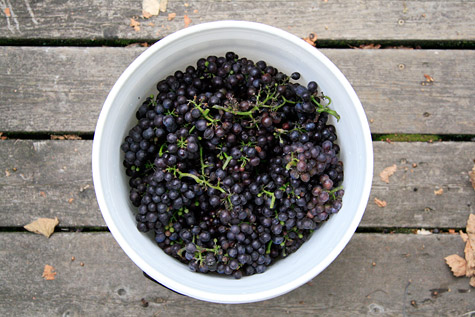About this supposedly crappy vintage

I don’t have any skin but grape skins in the game, so it’s been interesting to watch the pitched battle unfolding to define this vintage — before its wines have even finished fermenting, much less transmogrified into something someone could actually taste and evaluate.
On the one hand, there’s everything you’ve been reading in the media, or heard whispered by wine-wags in restaurants, wine shops and tasting rooms: the vintage is a complete wash. Low crop yields, waves of botrytis and powdery mildew, grapes wheezing toward ripeness (if at all), and the coup de grâce, ravenous birds. All have pounded the industry with the most challenging and grim harvest in decades.
On the other hand, you’ve got winemakers who’ve actually been out there, working the vines and the fruit. The ones I’ve talked to are stoic, but guardedly optimistic, arguing that the cooler weather has produced beautiful, elegant wines that truly express the uniqueness of Oregon – for the first time in years.
Keep in mind, of course, that their livelihood is utterly dependent on consumers’ preconceptions about a vintage. If a consensus develops that a vintage is great, it’ll fly off the shelves; but if the buzz is otherwise — or worse, that it’s a disaster — they’ll have trouble even moving it out of the bottling room. Would you fan the flames of the latter if your income depended on it? I didn’t think so.
So who’s right?
I think one answer may lie in the bucket you see above. That’s the sum total of the Giraud “estate” harvest from my back yard, about 25 pounds. Before the rains bore down a week or so ago, I frantically clipped what fruit I could salvage: probably half unripe and mildewed, half passable, and all told, 20 brix. Without some sugar, that would produce wine a shade above 11% alcohol, fine for Riesling but anemic for Pinot Noir.
So there you go: proof. The buzz is right, the vintage sucks.
But not so fast. I’m a rank, drooling amateur when it comes to farming grapes. Most years I’m lucky even to get a good crop of mildew, much less viable, fermentable fruit. That I got vaguely healthy grapes as high as 20 brix this year is nothing short of a miracle, in fact.
So if a yahoo with a hoe can do that, what do you think someone with years of training and experience can do? Take, for example, the fruit we brought in from Oracle Vineyard in the Dundee Hills, farmed by people who actually know what they’re doing. Totally clean, exceptional flavor, vivid acidity. Its numbers look great, and well within the ballpark of ideal for Pinot Noir.
I’ve heard a lot of that around the Valley. Sure, some horror stories, and certainly low yields, a tsunami that will roll dire economic consequences toward the shores of those without deep enough pockets. But at the same time, tales of great flavors and a chance to make a truly Oregon Pinot Noir, one balanced on the razor’s edge of ripeness where the varietal truly comes alive.
So that’s my read. In the hands of people who know what they’re doing — and didn’t panic — this vintage is going to produce some disarmingly elegant wines. Will Robert Parker anoint them with high scores? Unlikely. It’ll be nowhere near the syrah-like California style he favors. But will it earn high marks from those smart enough to snap up the tragically few that make it to market? Oh, yeah.
In the end, maybe what’s scariest about this vintage is that it’s kind of a ticking time bomb for less talented winemakers and growers. Everyone’s reputation will probably survive the year, but when 2010 wines hit the shelves, there will be nowhere to hide: the true measure of talent will be unflatteringly revealed in the glass.
9 comments9 Comments so far
Leave a reply

Fair and true assessment. We were ripe and tasty, along with several others. But the worry is that even the very nice wines will be tarred with a “2010 sucks” brush. Still hard to say how the wines will turn out, but “variable” may be the operative word. Several times over the past two weeks I wish I’d kept more of this tasty fruit for myself (especially given the low price for grapes), but then I’m reminded of the challenge associated with marketing a potentially dismissed vintage. Hopefully enough wines will live up to the potential of the vintage.
Thanks for the good insight. Rings true to what I have heard. Reminds me a bit of ’98 in California. Spectator and Parker pissed all over the cold, wet vintage, and indeed it was a challenging vintage that produced some bad wines. But there were also many charming — yes, charming! — Napa Cabs and Sonoma Pinots that year. And the beauty of it was that the lemmings avoided the vintage, making even the winning wines relatively cheap for the rest of us.
Thanks for the grower’s perspective, Todd. Glad I don’t have to sell this vintage in a year or so. That said, it’s also true that Portland boasts some pretty savvy wine media — I’m thinking of the O’s Katherine Cole in particular — who usually resist easy generalizations and take the time to separate the wheat from the chaff. So with luck, the goods ones will get a fair shake, at least locally.
Good point, Pete — always nice to wave as the lemmings thunder past!
A good assessment….
It is my sincere hope that the press learned a thing or two from the panning of the 2007 vintage. I am sure I am overly hopeful but I guy can dream..
It was definitely the year of the grower. With high disease pressure throughout the year and Hitchcockian bird pressure at the end, good vineyard management was and always is the key to success.
90% of my fruit came in perfectly ripe from a physiological point of view with sugars that will yield a nice 13.25% alcohol. Yields were already low from heavy green harvesting selection to insure ripeness and made lower by those damn birds. I am seriously thinking of taking down all the bird feeders in my yard if only to make me feel better.
Only time will tell what we truly have, I look forward to tasting the wines post malo.
You are on the mark! We all forget that Pinot Noir is an expression of the whole. It requires a delicate use of science, craftmanship of an artist and some luck.
Great comment, John, especially “Hitchcockian bird pressure” — you heard that perfect turn of phrase here first, folks! We’re just about to press our Pinot, and it’s smelling divine. As you say, looking forward to it on the other side of malo.
[…] at how things shaped up.So how did things turn out? That is a matter of perspective, just ask Les Garagistes. Because the weather was so cold all year, many growers had been dropping fruit to ensure that […]
May I remind you of another great wine from another famously crappy vintage (see the penultimate paragraph). Condolences and good luck to the growers and vintners who have to deal with broad-brush vintage assessments, but I have to admit to some selfish pleasure in anticipation of the odd bargain a couple of years from now.